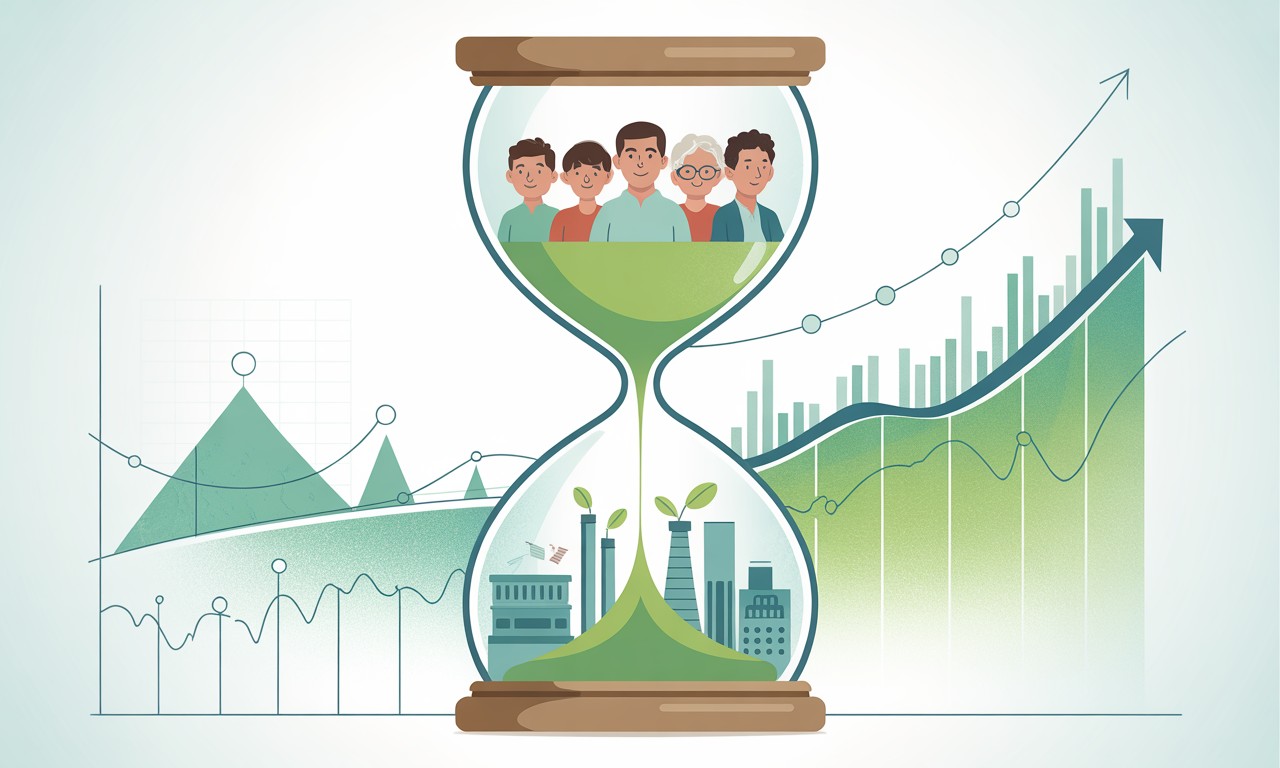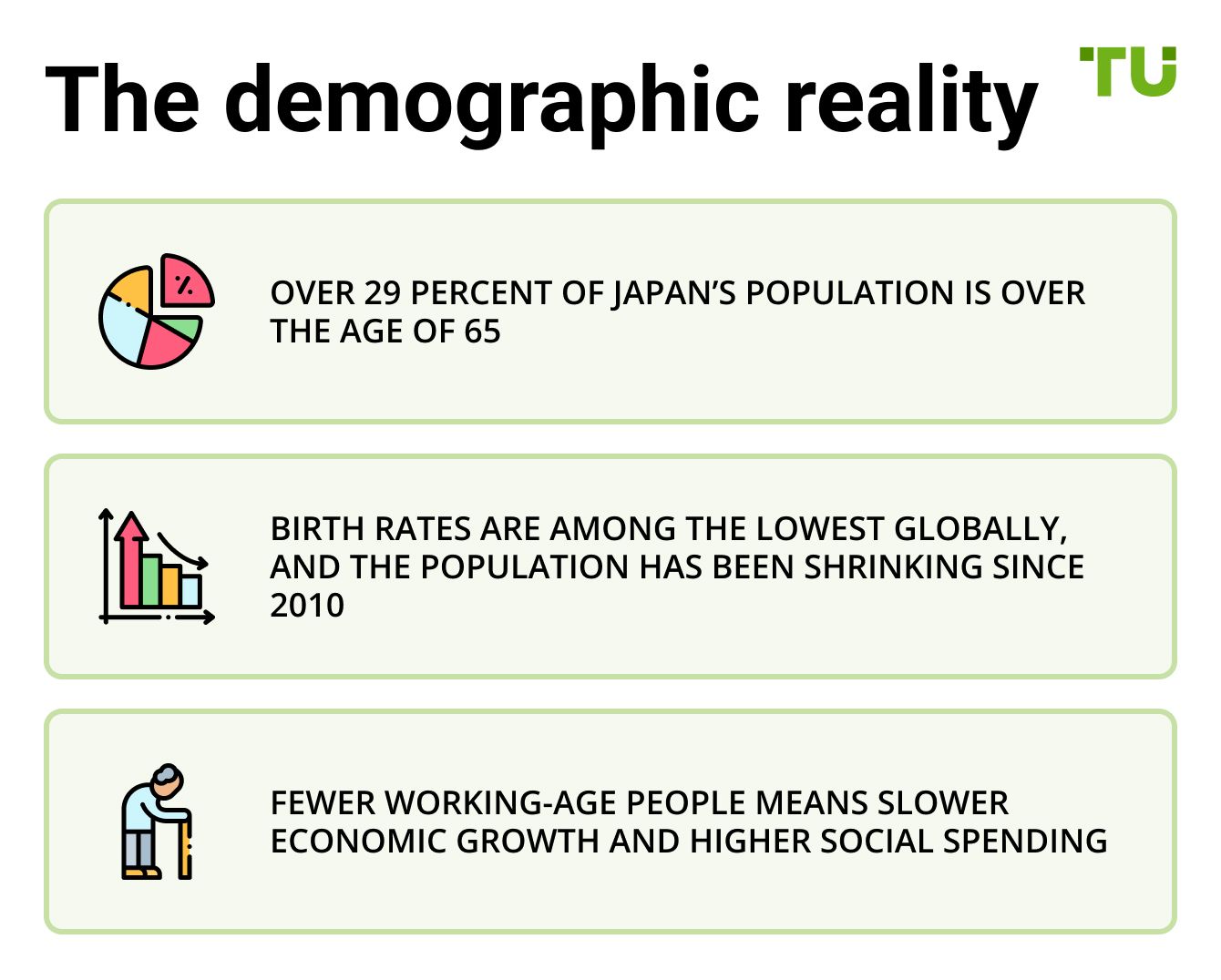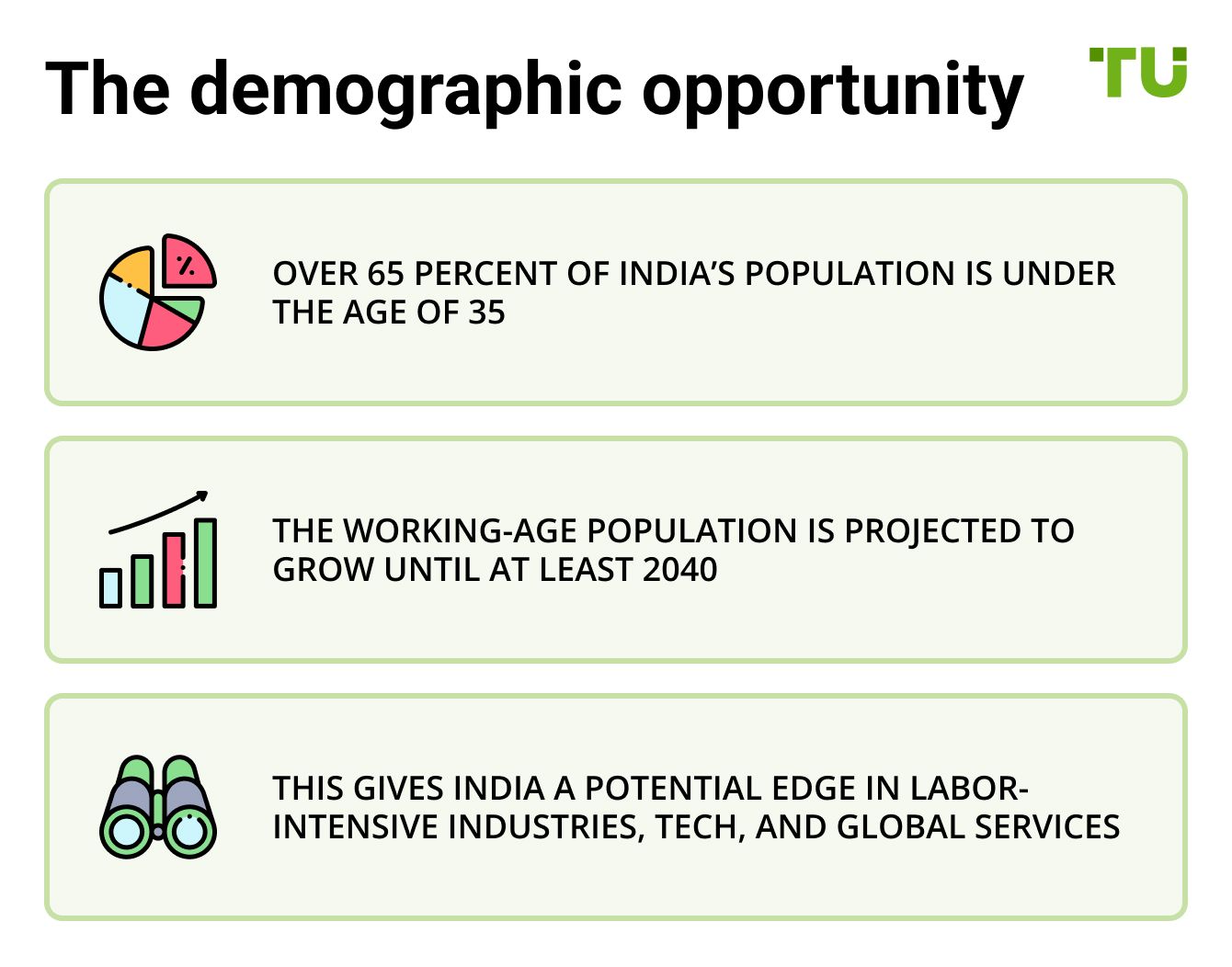How Demographic Shifts Are Reshaping Global Economies



Editorial Note: While we adhere to strict Editorial Integrity, this post may contain references to products from our partners. Here's an explanation for How We Make Money. None of the data and information on this webpage constitutes investment advice according to our Disclaimer.
Demographic shifts, especially aging populations or youth, directly influence economic growth, labor markets, pensions, and consumer trends. Countries that adapt early with smart policies in education, healthcare, immigration, and automation can turn demographic pressures into long-term economic advantages.
Demographics are not slow background trends. They are the silent engines behind every economic shift. When a population gets older or stops growing it changes how a country spends, borrows, invests and even thinks about risk. Most forecasts break because they treat people like constants not variables. But the real force shaping long-term growth is the age structure of a society.
A country with more retirees than workers is not just aging. It is rewiring its economy from inside out and no monetary policy can fully offset that. In this study, we will take a closer look at how demographic change is rewriting the rules for economies worldwide.
Risk warning: All investments carry risk, including potential capital loss. Economic fluctuations and market changes affect returns, and 40-50% of investors underperform benchmarks. Diversification helps but does not eliminate risks. Invest wisely and consult professional financial advisors.
Understanding demographic shifts

Demographics shape the future of every economy. Whether a population is getting older or growing younger, the long-term effects ripple through labor markets, healthcare systems, social security, and investment trends.
Global aging trends
More countries are facing aging populations, with longer life expectancies and falling birth rates.
What’s happening
Populations in Europe, North America, Japan, and South Korea are aging fast.
Birth rates have fallen below replacement levels in many developed economies.
People are living longer, pushing up healthcare and pension costs.
Economic impacts
Fewer working-age people mean slower labor force growth.
Older populations spend less on consumption and more on healthcare.
Governments face rising costs for pensions and public health services.
Why it matters
Aging slows down economic growth if not balanced by higher productivity.
Countries must rethink retirement, immigration, and automation to stay competitive.
Aging also changes investment patterns, as older populations shift to lower-risk assets.
Youthful populations in emerging economies
In contrast, many developing countries have young, fast-growing populations.
Where this is happening
Countries in Sub-Saharan Africa, South Asia, and parts of Latin America have median ages under 25.
Populations are expected to continue growing rapidly for decades.
Economic potential
A large, young workforce offers a chance for higher growth, known as the demographic dividend.
Young populations drive consumer demand in areas like education, housing, and digital services.
More workers can boost tax revenue and reduce dependency ratios — if jobs exist.
Challenges ahead
Without enough schools, infrastructure, and jobs, this potential can turn into frustration.
Youth unemployment, poor education, and political instability can hold back growth.
Governments need to invest early in education, health, and job creation to unlock the full benefit.
Why it matters
Youth-heavy economies may become the engines of global growth.
But the window to harness this advantage is limited — it depends on getting policy right, fast.
Impact on labor markets
As developed countries face worker shortages due to aging populations, younger nations have growing labor forces looking for opportunity. These shifts affect wages, productivity, migration patterns, and how companies plan for the future.
Labor shortages in developed nations
Many wealthier countries are struggling to fill open roles, especially in healthcare, construction, logistics, and tech. Retirements are rising fast, and with fewer young people being born over the years, there just aren't enough new workers stepping in. Tighter immigration rules have made the situation worse.
Some sectors are seeing wages go up to attract staff, but that hasn’t always translated into better productivity. Businesses are feeling the pinch through delays, higher costs, and slower growth. Governments are now weighing whether to bring in more foreign workers or encourage older employees to stay longer. How they handle education, immigration, and training will be critical to keeping their economies moving forward.
Opportunities in youthful labor markets
In contrast, countries like India, Vietnam, Bangladesh, and many across Africa have more young people looking for jobs each year. These workers are often eager to work, open to learning, and comfortable with technology. Companies around the world are starting to move operations to these regions to tap into this growing talent pool. But there’s a catch.
The number of available jobs doesn’t always match the number of people looking, and gaps in schooling, job training, and basic services can hold young workers back. Still, with smart investments in skills and infrastructure, these countries have a real shot at becoming leaders in making goods, providing services, and building new industries. The future depends on turning this youth wave into real economic power.
Pension systems under pressure
In many aging societies, there are fewer workers supporting more retirees. This shift is forcing governments to rethink how pensions are funded, who qualifies, and how long they need to last. Without action, some systems may become financially unsustainable.
Sustainability challenges in aging societies
In countries where more people are aging and fewer are being born, making pensions work without breaking the bank is getting tougher. People are living longer, which means retirement payments stretch out for decades. But with fewer young people joining the workforce, there’s a growing imbalance. Many pension systems rely on today’s workers to support retirees, and when the number of workers drops while retirees rise, government budgets start to feel the strain.
There’s also growing doubt among younger people about whether they’ll get the same support when they retire. Without action, governments may have to either slash benefits or raise taxes sharply. That’s why more people are rethinking their plans; working longer or saving more on their own to feel secure later.
Reforms and policy responses
To fix the system, many governments are raising the retirement age to match longer lifespans and adjusting how much future retirees get. Some are also expanding private retirement savings options to ease the load on state pensions. Others are offering financial perks to those who choose to retire later. At the same time, countries are looking beyond pensions; trying to get more people back into work, especially older adults and women, and even bringing in more working-age people through immigration.
A few systems now tie retirement payouts to how long people are living or how fast wages grow, helping keep things on track. The truth is, waiting too long only makes things harder to fix. The smartest changes are the ones that keep things fair and affordable as times change.
Case studies
Different countries face very different demographic challenges, and how they respond makes all the difference. Japan is dealing with a rapidly aging population and shrinking workforce, while India is trying to turn its youth-heavy population into a long-term economic advantage. Both offer valuable lessons on how population trends can shape national priorities.
Japan's aging population and economic strategies
Japan has the oldest population in the world, and its economy is feeling the pressure.
The demographic reality

Over 29 percent of Japan’s population is over the age of 65.
Birth rates are among the lowest globally, and the population has been shrinking since 2010.
Fewer working-age people means slower economic growth and higher social spending.
How Japan is responding
Pension reform. The government has raised the retirement age and is encouraging older adults to keep working.
Automation and robotics. Japanese firms lead in industrial robotics to offset labor shortages.
Workforce policies. Greater efforts to involve women and older workers in the labor market.
Immigration. Though still cautious, Japan is slowly opening more pathways for foreign workers.
Why it matters
Japan’s strategy focuses on productivity rather than population growth.
It shows how advanced economies can adapt through technology, workplace shifts, and slow policy evolution.
India’s demographic dividend
India is one of the youngest countries in the world and is at a turning point.
The demographic opportunity

Over 65 percent of India’s population is under the age of 35.
The working-age population is projected to grow until at least 2040.
This gives India a potential edge in labor-intensive industries, tech, and global services.
How India is responding
Education and skilling. Programs like Skill India aim to train millions in trades and digital skills.
Startup and innovation push. India has become a major tech hub, with government support for entrepreneurship.
Infrastructure development. Investments in roads, ports, and digital networks aim to support jobs and economic growth.
Labor reforms. Simplifying rules to attract investment and formalize the job market.
Why it matters
India’s challenge is turning population growth into real economic power.
If it invests well now, it could become one of the largest engines of global growth.
But if it falls short on jobs and education, the youth advantage could turn into a missed opportunity.
Technological adaptation and automation
From robotics to AI, automation is helping businesses maintain productivity even when the workforce is shrinking. At the same time, preparing people for this shift through education and skills training is just as important.
Role of technology in mitigating labor shortages
Automation is no longer a future trend; it’s a present-day solution for many sectors facing a shortage of workers.
How it's being used
Robotics in manufacturing, logistics, and even healthcare reduce the need for manual labor.
AI and machine learning automate routine tasks in finance, customer service, and retail.
Remote work tech helps companies tap talent globally, even in regions with declining populations.
Why it matters now
In aging societies, fewer workers are available for physical or repetitive jobs.
Automation fills the gaps, allowing companies to maintain output without increasing headcount.
It also reduces reliance on hard-to-fill roles in aging or low-growth regions.
Challenges to consider
Not all jobs can be automated, especially those requiring empathy or creativity.
Small businesses may struggle with the cost of adoption.
There’s a risk of increasing inequality if automation outpaces workforce reskilling.
Investment in human capital development
As technology reshapes work, countries must invest in their people to ensure they’re ready for the future.
What human capital investment means
Education reform that focuses on digital literacy, problem solving, and adaptability.
Vocational training and upskilling for workers in industries being disrupted by automation.
Public-private partnerships to build skills pipelines that match real industry needs.
Why it matters
A tech-driven economy still needs humans who can manage, innovate, and create.
Reskilling helps workers shift from declining sectors into new growth areas.
Countries with well-trained workforces can attract more investment and remain globally competitive.
Real-world approaches
Germany’s dual education system blends classroom learning with hands-on apprenticeship.
Singapore offers mid-career training grants and AI readiness programs for workers of all ages.
Nordic countries tie social support with mandatory reskilling initiatives.
Economic growth and productivity
Demographic shifts are putting a new kind of pressure on economic growth. As workforces age and populations shrink in many countries, productivity becomes the key to staying competitive. Slower labor force growth doesn’t have to mean slower economies but only if countries adapt by investing in people, innovation, and smarter workforce strategies.
Effects of an aging workforce on productivity
With more people working well into their 50s, 60s, and even 70s, the workplace is changing in noticeable ways. Older workers bring experience, but they also eventually step back or retire, and younger workers aren’t filling in fast enough. This can make work less efficient, especially in jobs that require a lot of energy or quick learning of new tech.
If experienced people leave without passing on their know-how, companies may feel that loss for years. At the same time, more money goes toward healthcare and support services for an aging population, leaving less for things that help people work better and faster. As the workforce shrinks, there’s more focus on getting the most out of every employee through better training, smarter tools, and more thoughtful workplaces.
Harnessing the potential of older workers
An older team doesn’t have to slow things down, as long as employers are willing to adjust. Older workers often bring a lifetime of hands-on knowledge, show up consistently, and can be incredible mentors for younger colleagues. Many also want to stay involved, especially if they can work fewer hours or more flexible shifts.
To keep them engaged, companies should offer better-designed workspaces, lighter physical tasks, and give older staff chances to learn and grow. Rules that protect against treating older workers unfairly also matter. When companies make room for different generations to work together, they often see stronger performance, and keeping experienced hands on deck can ease staffing shortages and keep the business growing in a healthy way.
If you are a beginner making your way through fundamental investing, you would need an account with a broker to materialize your research into actual investments. In the table below, we have presented the top brokers for beginners, offering a wide range of assets and simple user interface:
| Currency pairs | Crypto | Stocks | Min. deposit, $ | Max. leverage | Demo | Regulation | TU overall score | Open an account | |
|---|---|---|---|---|---|---|---|---|---|
| 60 | Yes | Yes | 100 | 1:300 | Yes | FCA, CySEC, MAS, ASIC, FMA, FSA (Seychelles) | 6.83 | Open an account Your capital is at risk. |
|
| 90 | Yes | Yes | No | 1:500 | Yes | ASIC, FCA, DFSA, BaFin, CMA, SCB, CySec | 7.17 | Open an account Your capital is at risk.
|
|
| 68 | Yes | Yes | No | 1:200 | Yes | FSC (BVI), ASIC, IIROC, FCA, CFTC, NFA | 6.8 | Open an account Your capital is at risk. |
|
| 80 | Yes | Yes | 100 | 1:50 | Yes | CIMA, FCA, FSA (Japan), NFA, IIROC, ASIC, CFTC | 6.95 | Study review | |
| 100 | Yes | Yes | No | 1:30 | Yes | SEC, FINRA, SIPC, FCA, NSE, BSE, SEBI, SEHK, HKFE, IIROC, ASIC, CFTC, NFA | 6.9 | Open an account Your capital is at risk. |
Where aging populations quietly rewrite economic rules
One thing most people overlook is that working-age population growth is more powerful than productivity growth in the short term. A country can have brilliant innovation and still slow down if it has fewer workers. Japan showed this decades ago. Once its workforce shrank the economy lost steam even though it stayed tech-savvy. If you want to read future growth trends correctly, look at the number of 25 to 54-year-olds. When that group flattens or falls the economy usually softens too no matter how strong the stock market looks.
Another mistake is thinking immigration always solves demographic trouble. It only works when the incoming population is young, skilled and stays long enough to become part of the system. Many countries bring in migrants to boost numbers but if they stay on the margins without full access to jobs or services the benefits fade fast. So instead of just counting heads, smart countries plan for how to include newcomers fully. Without integration there is no demographic payoff. Just a delayed reckoning.
Conclusion
Demography shapes the foundation of any economy quietly but completely. Growth does not just depend on capital or policy but on how many people are working and spending across time. Countries that ignore population structure end up trying to push growth with tools that no longer fit. And by the time they feel the full impact it is often too late to pivot. Watching demographic trends is not just for sociologists. It is a survival skill for anyone who wants to see where real economic power is headed.
FAQs
How do demographic changes influence housing markets?
Aging populations can reduce housing demand and shift it toward downsizing or senior living, while younger, growing populations tend to drive demand for starter homes and rentals. Regional population shifts also affect price dynamics.
What lessons can be learned from countries successfully managing demographic transitions?
Countries like Sweden and Japan have shown that proactive policies in healthcare, pension reform, workforce participation, and immigration can ease demographic strain. Long-term planning and adaptability are key to managing aging societies.
How do demographic trends impact education and skill development policies?
Shifts in age structures require updates in education focus, with declining youth populations pushing quality over quantity. Lifelong learning and reskilling become vital as aging workforces need to stay productive longer.
What role does immigration play in addressing labor shortages?
Immigration helps offset declining birth rates and fills gaps in both high-skill and essential low-skill jobs. When well-managed, it supports economic growth, sustains tax bases, and stabilizes social support systems.
Related Articles
Team that worked on the article
Anton Kharitonov is an active trader and analyst. He employs both short- and long-term trading strategies, primarily based on fundamental factors, supported by technical indicators and intermarket analysis. Anton trades major and minor currency pairs, while his primary focus is on oil futures and index CFDs.
As a financial expert and analyst at Traders Union since 2013, Anton performs thorough internal broker evaluations, referred to as “test drives.” He examines website and account interfaces, client support, software stability, deposit and withdrawal processing speed, legal documentation, and additional broker services such as VPS, affiliate programs, contests, bonuses, and training programs.
New knowledge is the key to expanding our horizons and unlocking new opportunities. Every step in learning, every new understanding empowers us become better, smarter, and stronger. Knowledge provides an advantage, enabling informed decisions, confident actions, and forward momentum. In a changing world, only those who embrace learning and adaptation can truly thrive.
Based on these evaluations, Anton prepares expert reports on the operation of Forex, stock, binary options, and cryptocurrency exchanges.
Chinmay Soni is a financial analyst with more than 5 years of experience in working with stocks, Forex, derivatives, and other assets. As a founder of a boutique research firm and an active researcher, he covers various industries and fields, providing insights backed by statistical data. He is also an educator in the field of finance and technology.
As an author for Traders Union, he contributes his deep analytical insights on various topics, taking into account various aspects.
Mirjan Hipolito is a journalist and news editor at Traders Union. She is an expert crypto writer with five years of experience in the financial markets. Her specialties are daily market news, price predictions, and Initial Coin Offerings (ICO).
Forex leverage is a tool enabling traders to control larger positions with a relatively small amount of capital, amplifying potential profits and losses based on the chosen leverage ratio.
Index in trading is the measure of the performance of a group of stocks, which can include the assets and securities in it.
Diversification is an investment strategy that involves spreading investments across different asset classes, industries, and geographic regions to reduce overall risk.
Cryptocurrency is a type of digital or virtual currency that relies on cryptography for security. Unlike traditional currencies issued by governments (fiat currencies), cryptocurrencies operate on decentralized networks, typically based on blockchain technology.
CFD is a contract between an investor/trader and seller that demonstrates that the trader will need to pay the price difference between the current value of the asset and its value at the time of contract to the seller.






























































































































